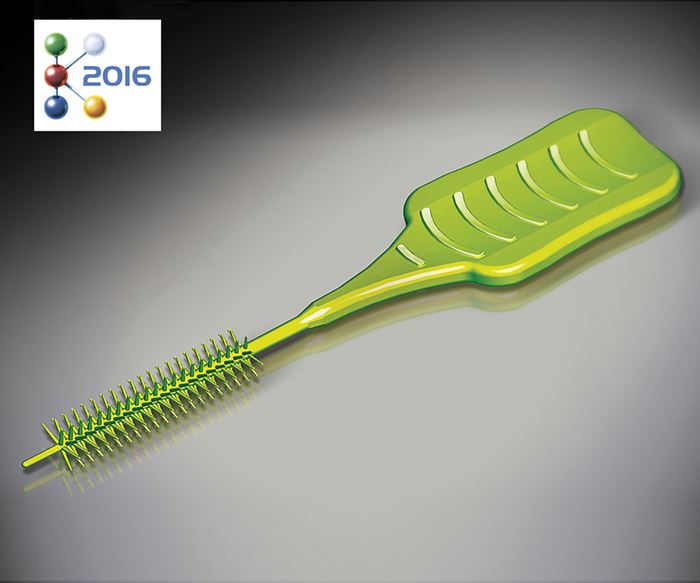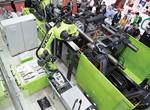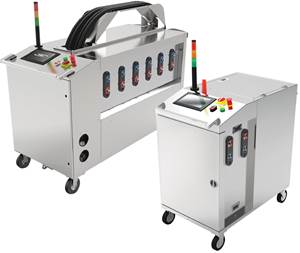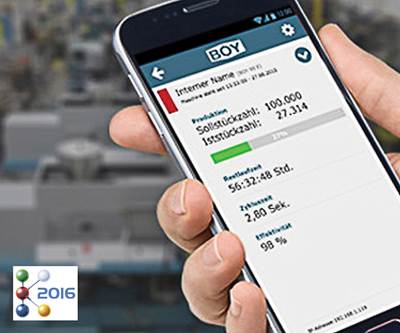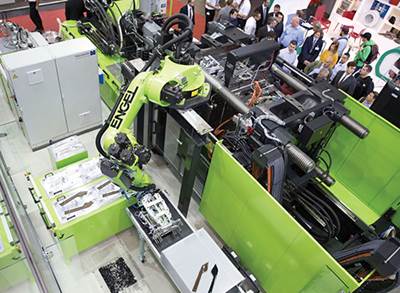INJECTION MOLDING: New Robots & Automation Solutions Coming to K 2016 Show
Look for modular automation systems, new controls, and new robots and pickers.
In addition to other injection molding news at K 2016, previewed on p. 52, several new robots and sprue pickers will debut in Dusseldorf next month. Modular automation will be a recurring theme.
• Engel (U.S. office in York, Pa.) and automation supplier Hekuma of Germany will team up to present a particularly tricky application: molding eight interdental brushes, each having up to 500 integrally molded bristles (photo), with a total shot weight of only 1.93 g. Up to now, these brushes consisted of three parts produced separately—the grip, a wire mesh, and the filaments. Now, it’s all one shot with no metal insert. Instead, the compound contains glass fibers that stiffen the grip and core but do not penetrate the very delicate bristle areas. The mold comes from Hack Formenbau in Germany.
Hekuma’s automation demolds the brushes and presents each 50th shot for camera inspection. It also packages two shots together in one pouch. The automation system is an example of the new HEKUflex concept of modular automation, shown first at NPE2015, which is designed to reduce engineering costs and speed installation and startup. For easy mixing and matching of functional modules, each module has its own controller.
This cell also allows Engel to show off its control capabilities. A 170-m.t. all-electric e-motion T press utilizes iQ weight control to analyze the pressure profile for each shot at various screw positions and adjusts both the switchover point and the injection profile as needed. Meanwhile, iQ clamp control monitors the mold breathing for each shot and adjusts the clamp force to the minimum required to prevent flashing. And an e-flomo system monitors and adjusts water flow in each cooling circuit to keep mold temperature constant.
• Meanwhile, Engel will highlight its new modular automation concept, called easicell, in the DecoJect IMD application described on p. 58. Standardized modules reportedly make it easy to integrate robots and other processing and handling—such as laser cutting and marking, plasma surface treatment, application of PUR seals, and tray or box transfers—upstream and downstream of molding.
• As reported in last month’s Keeping Up, Engel also will introduce two new servo robots at K. One is a four-axis SCARA robot that extends the easix line, which previously consisted of six-axis articulated models. The SCARA model reportedly offers much higher speed at lower cost for pick-and-place, stacking, and palletizing operations. Based on Staubli hardware, it can be fully integrated into Engel’s CC300 machine controller.
• Also new is a servo sprue picker based on the e-pic model shown at NPE2015, but with one fewer axis. It combines a linear vertical axis with a vertical swivel arm, but has no horizontal axis like the e-pic. Instead, it rotates up to 110° on its pedestal.
• KraussMaffei (U.S. office in Florence, Ky.) will highlight its mobile “plug-and-play” automation cells based on a small six-axis robot with a payload of 10 kg (22 lb) and reach of 1100 mm (43 in.). The cell can be integrated into the machine control—or the robot pendant can operate the injection machine. The mobile cell is said to make it easy to add further peripherals, such as camera inspection.
• KM also is showcasing its new LRX TwinZ arrangement of two linear servo robots on one horizontal Z axis. It’s aimed at stack molds or for transferring parts (“handshake”) during complex operations, such as an organosheet composite overmolding demonstration at the show (see this month's injection molding show preview). Programming and control of both robots can be integrated into the MC6 machine control. This system can handle configurations of up to four robots, each with up to six axes.
• Wittmann Battenfeld (U.S. office in Torrington, Conn.) plans to show its new R9 robot controller and a re-engineered IML workcell for quicker label changes. Several other new robot developments were shown at the company’s recent 40th anniversary celebration in Vienna, though it was not revealed which of these might appear in Dusseldorf (see August Close Up).
• New from Sepro of France (U.S. office in Warrendale, Pa.) is the 6X-400, a six-axis, articulated-arm robot that results from a recent partnership between Sepro and Yaskawa Motoman of Japan. It’s the largest of four models introduced recently for presses of 800 to 5000 tons, which complement smaller models developed with Staubli and complete Sepro’s six-axis line.
The 6X-400 model at the show will have a reach radius just over 4 m (13 ft) and can carry up to 120 kg (264 lb) payload. It is designed to be shelf-mounted on top of the fixed platen or another raised structure, making it one of the largest shelf-mounted robots in the world. It is operated by Sepro’s Visual 3 control, which is used for all Sepro robots.
At the opposite end of the size spectrum, Sepro will introduce two small robots. One is the Success 5 economical, three-axis servo robot with 3-kg (6.6-lb) payload capacity, 400 mm strip stroke, and 1000 mm vertical stroke. Pneumatic R1 (0-90°) wrist rotation is standard and R3 rotation (0-90° or 0-180°) is optional.
The other entry is the S5 servo picker. It comes with three axes and simple sprue gripper standard, but can be fitted with simple R1 wrist rotation and simple end-of-arm tooling. It comes with unloading chute and guarding.
• Boy Machines (U.S. office in Exton, Pa.) will again demonstrate the collaborative robot technology unveiled at Fakuma 2015 (see Dec. ’15 Close Up). These jointed-arm robots require no guarding to work around people. A Boy 35 VV vertical press will mold drink glasses, which will be demolded by a standard six-axis robot. On request, the glasses will be individually labeled with a name and filled. A second robot—this one of the collaborative type—will hand the filled glass directly to the visitor.
• Arburg (U.S. office in Rocky Hill, Conn.) promises a new Multilift linear robot, but released no details.
Related Content
System Offers 'Lights Out' Mold-Channel Cleaning & Diagnostics
New system automatically cleans mold-cooling lines—including conformal channels—removing rust and calcium, among other deposits, while simultaneously testing for leaks, measuring flow rate and applying rust inhibitor.
Read MoreAI: The Next Big Thing in Plastics Processing
Discover how artifical intelligence is revolutionizing plastics processing. Hear from industry experts on the future impact of AI on your operations and envision a fully interconnected plant.
Read MoreProcessing Megatrends Drive New Product Developments at NPE2024
It’s all about sustainability and the circular economy, and it will be on display in Orlando across all the major processes. But there will be plenty to see in automation, AI and machine learning as well.
Read MoreWhat to Look for in High-Speed Automation for Pipette Production
Automation is a must-have for molders of pipettes. Make sure your supplier provides assurances of throughput and output, manpower utilization, floor space consumption and payback period.
Read MoreRead Next
K 2016 Preview: Injection Molding
Adapting injection molding to the concept of Industry 4.0 is gaining momentum. At this show you’ll see that the interconnected, integrated “factory of the future” is almost here.
Read MoreHighlights of Fakuma 2015
A selection of the hottest news and molding trends at this “little brother” to the K Show.
Read More
